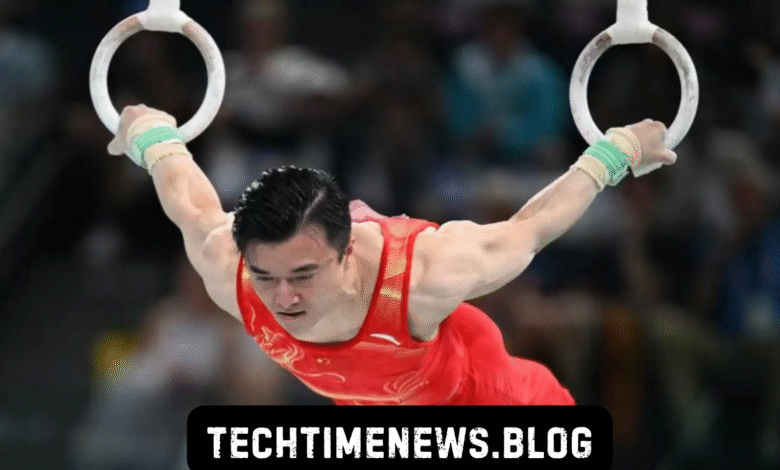Introduction to Gymnastics Rings Olympics

Gymnastics Rings Olympics among the most iconic and visually stunning apparatuses in Olympic gymnastics Known for the immense strength, control, and precision required to perform routines, this discipline captivates audiences worldwide. The rings event, part of the men’s artistic gymnastics program, showcases pure upper-body power combined with perfect balance and artistry. Since its introduction into the modern Olympic Games, the event has maintained a reputation for demanding physical excellence at the highest level.
Historical Development of Rings in the Olympic Games
The rings apparatus has roots in the early days of organized gymnastics in Europe. Gymnastics rings were first introduced into Olympic competition at the 1924 Paris Games as a dedicated event for men. Early routines focused primarily on swinging and strength positions, lacking the highly complex transitions and holds that define modern gymnastics. As the sport evolved, so did the difficulty of movements, with each generation of athletes pushing boundaries. Over the decades, advances in training, equipment design, and judging criteria transformed the rings into one of the most challenging apparatuses in men’s gymnastics.
Technical Characteristics of the Rings Apparatus
Gymnastics rings are suspended from a frame or ceiling by two long straps, allowing the apparatus to swing freely. This instability requires extraordinary stabilization from the gymnast. The rings themselves are made of wood or composite materials designed to provide a firm grip. Athletes must demonstrate a combination of static holds, such as the iron cross, planche, and inverted cross, along with dynamic elements, including swings, dismounts, and strength-to-strength transitions. Maintaining strict control without excessive swinging is critical because deductions are made for any unnecessary movement or loss of form.
Judging Criteria and Scoring System
In the Olympic Games, the rings event is scored according to the Code of Points established by the International Gymnastics Federation (FIG). Routines are evaluated on two main components: difficulty and execution. Difficulty refers to the value assigned to each skill performed, with more complex strength holds or dismounts carrying higher point values. Execution measures precision, control, body alignment, and artistic presentation. Judges deduct points for bent Gymnastics Rings Olympics swinging, or improper holds. The combination of these factors results in a final score that determines the athlete’s ranking in competition.
Evolution of Skills and Difficulty Over Time
In earlier Olympic competitions, rings routines were far less complex than today. Early gymnasts relied on simpler strength positions and minimal swinging motions. However, as training methods improved, athletes began developing greater muscular control and experimenting with new positions. The introduction of skills like the Maltese cross, inverted cross, and advanced dismounts significantly raised the difficulty level. Today, Olympic gymnasts perform routines filled with multiple high-value strength holds connected by seamless transitions, making the rings a true test of both strength and artistry.
Legendary Performers in the Rings Event
The Olympic history of gymnastics rings is filled with legendary athletes whose performances have set new standards. Gymnasts such as Albert Azaryan of Armenia, famous for the “Azaryan Cross,” and modern champions like Chen Yibing of China and Eleftherios Petrounias of Greece have become icons of this apparatus. These athletes demonstrated exceptional mastery of strength holds, near-perfect execution, and innovative elements that influenced how routines are constructed for future generations. Their dominance on the rings has earned them Olympic gold medals and secured their names in the history books of gymnastics.
Physical Demands of Training on Rings
Training for the Olympic rings event is one of the most grueling regimens in the world of athletics. Gymnasts spend years building the necessary upper-body strength, core stability, and grip endurance to perform difficult holds. Specific exercises target the shoulders, biceps, triceps, chest, and back, along with isometric training to improve muscle control during static positions. Athletes also practice flexibility and joint conditioning to prevent injuries, as the intense pressure on tendons and ligaments can be extreme. The dedication required reflects not only physical preparation but also mental resilience to perfect routines under Olympic pressure.
Importance of Body Control and Precision
Unlike some apparatuses that allow slight adjustments during performance, rings routines demand complete stillness during static holds. Even a minor shake or swing can lead to deductions. Olympic gymnasts spend hours practicing how to engage stabilizing muscles to keep the rings perfectly steady. Precision in body alignment, such as maintaining straight arms during strength holds and fully extended positions in swings, is critical. This high standard makes rings one of the purest measures of an athlete’s upper-body strength and discipline.
Role of Coaching and Technique Development
Behind every successful Olympic rings gymnast stands an experienced coaching team. Coaches design training plans that balance strength development, skill acquisition, and recovery. They focus on perfecting technique in each element, ensuring athletes maintain proper body positions to maximize scores and minimize injury risks. Modern coaching also includes video analysis to study routines in slow motion, identifying small technical flaws that may not be visible to the naked eye. By combining traditional strength conditioning with modern sports science, coaches help athletes meet the ever-rising difficulty standards in Olympic rings competition.
Equipment Innovations and Safety Standards
Over the years, improvements in ring apparatus construction have enhanced both safety and performance. Earlier rings were prone to wear and lacked consistency in grip, but modern designs use durable, lightweight materials to ensure stability and reliability. Straps are made of high-strength fibers with adjustable mechanisms for precise height settings. Safety mats and landing platforms have also improved, providing better cushioning during dismounts. These innovations allow athletes to train and compete at higher levels while reducing injury risk, though the event remains one of the most physically demanding in gymnastics.
Psychological Pressure of Olympic Competition
Competing on rings at the Olympics brings immense mental pressure. Gymnasts must execute routines with absolute precision in front of judges, a live audience, and millions watching worldwide. Any lapse in concentration can lead to costly mistakes. Mental preparation techniques, including visualization, breathing control, and sports psychology sessions, play a vital role in helping athletes perform at their peak. Confidence built during training must translate seamlessly to competition day, where consistency and focus determine success on this unforgiving apparatus.
Rings as a Showcase of Gymnastics Artistry and Power
The rings apparatus uniquely blends raw physical strength with artistic presentation. While strength elements like the iron cross or Maltese cross demonstrate power, gymnasts must also display fluidity and elegance in transitions between positions. Olympic judges reward not just strength but also how skillfully routines are composed and performed. Athletes must create sequences that flow naturally, avoiding abrupt or jerky movements. This combination of power and artistry is what makes the rings event both technically demanding and aesthetically inspiring.
Memorable Olympic Moments in Rings History
Throughout Olympic history, there have been unforgettable performances that left audiences in awe. Albert Azaryan’s dominance in the 1950s, when he introduced new strength holds, set a precedent for innovation. In recent years, athletes like Eleftherios Petrounias, known as the “Lord of the Rings,” captured global attention with flawless routines that earned him Olympic gold. These moments showcase how the rings apparatus continually evolves while preserving its tradition of celebrating unparalleled human strength and precision.
Current Trends and Future of Rings Competition
The current generation of Olympic gymnasts continues to push boundaries by integrating even more difficult elements and connections into routines. Strength holds are combined with swing elements and high-difficulty dismounts, resulting in higher overall difficulty scores. Looking to the future, advancements in sports science, biomechanics, and nutrition may allow athletes to achieve even greater physical conditioning. As a result, Olympic rings routines will likely become more complex and visually striking, maintaining their status as one of the ultimate tests of athletic performance.
Global Influence and Training Programs Worldwide
The popularity of the rings event has inspired training programs far beyond traditional gymnastics powerhouses. Countries across Europe, Asia, and the Americas have invested heavily in developing gymnasts with specialized training in rings. International camps, coaching exchanges, and access to better equipment have created a more competitive global field. Nations like China, Japan, Greece, and Russia have consistently produced world-class rings athletes, and emerging programs are beginning to challenge established leaders by emphasizing advanced conditioning methods and innovative skill development.
Challenges Facing Gymnasts in Rings Competition
Despite technological and training advances, competing on rings at the Olympic level remains incredibly challenging. The risk of injury from overtraining, particularly to the shoulders and elbows, is significant. Maintaining the delicate balance between increasing strength and preserving flexibility is crucial to long-term success. Athletes also face challenges related to travel schedules, high-stakes qualification systems, and the pressure of representing their countries on the world stage. Overcoming these obstacles requires discipline, support from a strong coaching staff, and an unwavering commitment to excellence.
Legacy of the Rings Apparatus in Olympic Gymnastics
The rings event has earned a unique place in Olympic history as a discipline that embodies the pure essence of strength and control. Its champions are remembered not only for their medals but also for their contributions to advancing the sport. By continuously elevating the difficulty of routines, generations of athletes have ensured that the rings remain one Gymnastics Rings Olympics of the most respected and admired apparatuses in gymnastics. This legacy inspires future athletes to pursue perfection and honors the tradition of athletic excellence on which the Olympics were built.
Conclusion
The gymnastics rings event in the Olympics stands as a timeless symbol of human strength, precision, and artistic expression. From its origins in early 20th-century competitions to the modern era of unparalleled difficulty, the rings have challenged athletes to push beyond physical limits while maintaining perfect control. Through legendary champions, technical innovations, and relentless training, the apparatus continues to evolve, capturing the admiration of fans and preserving its place as one of the most demanding events in the Olympic Games. Its enduring legacy ensures that future generations of gymnasts will strive to reach new heights on the rings, keeping alive the spirit of athletic excellence.



